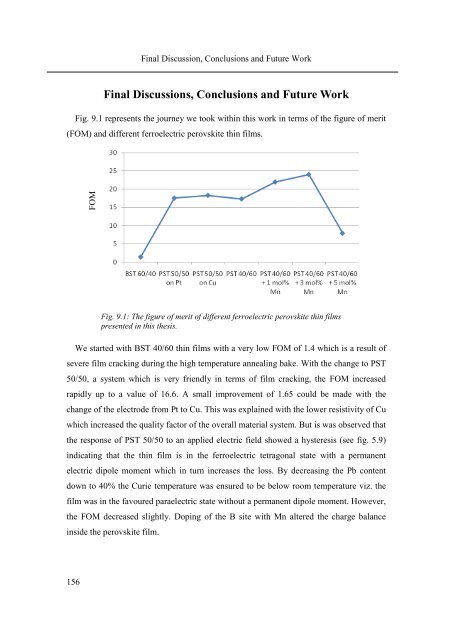PhD Thesis Arne Lüker final version V4 - Cranfield University
PhD Thesis Arne Lüker final version V4 - Cranfield University
PhD Thesis Arne Lüker final version V4 - Cranfield University
You also want an ePaper? Increase the reach of your titles
YUMPU automatically turns print PDFs into web optimized ePapers that Google loves.
156<br />
Final Discussion, Conclusions and Future Work<br />
Final Discussions, Conclusions and Future Work<br />
Fig. 9.1 represents the journey we took within this work in terms of the figure of merit<br />
(FOM) and different ferroelectric perovskite thin films.<br />
FOM<br />
Fig. 9.1: The figure of merit of different ferroelectric perovskite thin films<br />
presented in this thesis.<br />
We started with BST 40/60 thin films with a very low FOM of 1.4 which is a result of<br />
severe film cracking during the high temperature annealing bake. With the change to PST<br />
50/50, a system which is very friendly in terms of film cracking, the FOM increased<br />
rapidly up to a value of 16.6. A small improvement of 1.65 could be made with the<br />
change of the electrode from Pt to Cu. This was explained with the lower resistivity of Cu<br />
which increased the quality factor of the overall material system. But is was observed that<br />
the response of PST 50/50 to an applied electric field showed a hysteresis (see fig. 5.9)<br />
indicating that the thin film is in the ferroelectric tetragonal state with a permanent<br />
electric dipole moment which in turn increases the loss. By decreasing the Pb content<br />
down to 40% the Curie temperature was ensured to be below room temperature viz. the<br />
film was in the favoured paraelectric state without a permanent dipole moment. However,<br />
the FOM decreased slightly. Doping of the B site with Mn altered the charge balance<br />
inside the perovskite film.

















